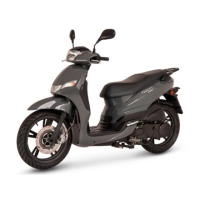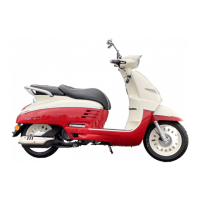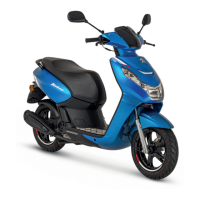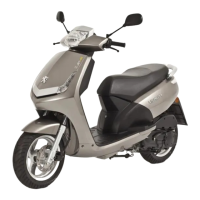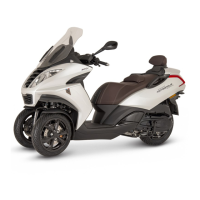Do you have a question about the PEUGEOT SPEEDFIGHT 2021 and is the answer not in the manual?
Guidelines for keeping and using the user manual as an integral part of the vehicle.
Obligation to wear approved helmet and gloves, advice on clothing, and legal requirements.
Warnings about alcohol, drugs, speed, and hot engine components.
Guidelines on approved accessories, load limits, and prohibitions on modifications.
Unladen weight, in working order, and maximum authorized total weight.
Key dimensions of the vehicle illustrated with diagrams.
Details about engine type, capacity, power, torque, cooling, fuel, spark plug, and lubrication.
Information on anti-pollution standards, fuel consumption, and CO2 emissions.
Specifies capacities for engine oil, relay box oil, fuel tank, and fork oil.
Details tyre dimensions and minimum load index/speed ratings.
Lists recommended tyre pressures for solo and pillion riders in bars.
Describes front and rear suspension types and travel.
Details front and rear brake types and sizes.
Lists specifications for headlights, bulbs, and battery.
Identifies manufacturer's plate, VIN, engine number, and tyre pressure label.
Specifies the type of unleaded fuel (RON/ROZ min. 95) and E5/E10 compatibility.
Lists recommended engine oil, relay box oil, grease, brake fluid, and fork oil.
Explains symbols for recyclability, hazards (explosive, flammable, corrosive, toxic), and warnings.
Explains symbols for people's safety, vehicle hazard, and important notes.
Identifies and labels various parts of the vehicle using numbered diagrams.
Explains the functions of the dipped lights/headlights switch, horn, and indicators switch.
Details the starter switch and the functions of the key-operated ignition switch positions.
Explains the multi-function display, warning lights, and main beam control.
Describes the speedometer and how to change between km/h and mph units.
Explains how to read the fuel gauge, reserve levels, and diagnostic warnings.
Explains how to display total and daily distance, and reset the tripmeter.
Describes the maintenance indicator and how to reset the maintenance counter.
Details the USB socket's power rating and how to connect devices or a holder.
Emphasizes the importance of checking vehicle condition for safety and reliability.
Advises familiarizing with controls and ensuring safe starting conditions for the engine.
Provides tips for smooth acceleration, braking, load management, and tyre pressure for fuel economy.
Warns against driving in flooded roads and provides specific speed and braking advice if unavoidable.
Checks for fuel level and leaks.
Checks the engine oil level and topping up if necessary.
Checks brake operation, pad wear, and fluid level.
Checks drum brake operation and linings, and vehicle lighting/signalling.
Checks tyre wear, pressure, steering rotation, and central stand operation.
Checks throttle handle smoothness and return.
Steps for starting the engine using the starter button, including brake lever usage.
Steps for starting the engine using the kick-start lever.
Steps for moving off from a standstill with the engine running.
Explains how to use the throttle for accelerating and decelerating.
Advises coordinating both brake levers for effective braking and avoiding wheel lock.
Warnings about sudden braking on wet roads/bends and on steep slopes.
Steps for switching off the engine and parking the vehicle securely.
Instructions for safely filling the fuel tank, including engine off requirement and overflow precautions.
Advice on engine use during the initial 0-1000 km for optimal performance and lifetime.
Emphasizes following the servicing schedule for warranty and reliability.
Advises using registered dealers for maintenance and repairs with genuine parts.
Guidelines for disposing of worn parts, batteries, and end-of-life vehicles.
Advises on using gentle cleaning products and avoiding high-pressure cleaners.
Instructions for washing with soapy water, rinsing, drying, and drying brakes.
Details on removing the spark plug, measuring electrode gap, and tightening torque.
Instructions for fitting, screwing, and tightening the spark plug correctly.
Step-by-step guide to checking the engine oil level using the gauge.
Advises using a dealer for draining and provides steps for draining oil when warm.
Instructions for refilling the engine with the correct quantity and type of oil.
Advises dealer use and provides steps for draining relay box oil when the engine is warm.
Instructions for refilling the relay box with the correct quantity and type of oil.
Procedures for removing the air filter cover, filter, cleaning, and fitting a new one.
Specifies the correct throttle cable play and how to adjust it.
Emphasizes regular cold tyre pressure checks and their importance for wear and safety.
Advises on tyre wear limits, dealer replacement, and prohibition of inner tubes in tubeless tyres.
How to check front brake pad wear and when replacement is needed.
How to check rear brake lining wear using a wear mark.
How to check brake fluid level via inspection window and when to consult a dealer.
Warnings about handling battery electrolyte, explosive gases, and avoiding booster chargers.
Advice on battery maintenance during periods of extended storage.
Guidelines for charging the battery safely and correctly, advising dealer assistance.
Specific care instructions for maintenance-free batteries.
Step-by-step instructions for safely removing and installing the vehicle battery.
Explains how to identify a faulty fuse and lists fuse ratings for electrical equipment.
Advises on switching off ignition, finding the cause of blown fuses, and using correct rating replacements.
Advises contacting a dealer for headlight bulb replacement and mentions removing the front upper shield.
Explains how to adjust the left and right headlights using adjustment screws.
Guidelines for keeping and using the user manual as an integral part of the vehicle.
Obligation to wear approved helmet and gloves, advice on clothing, and legal requirements.
Warnings about alcohol, drugs, speed, and hot engine components.
Guidelines on approved accessories, load limits, and prohibitions on modifications.
Unladen weight, in working order, and maximum authorized total weight.
Key dimensions of the vehicle illustrated with diagrams.
Details about engine type, capacity, power, torque, cooling, fuel, spark plug, and lubrication.
Information on anti-pollution standards, fuel consumption, and CO2 emissions.
Specifies capacities for engine oil, relay box oil, fuel tank, and fork oil.
Details tyre dimensions and minimum load index/speed ratings.
Lists recommended tyre pressures for solo and pillion riders in bars.
Describes front and rear suspension types and travel.
Details front and rear brake types and sizes.
Lists specifications for headlights, bulbs, and battery.
Identifies manufacturer's plate, VIN, engine number, and tyre pressure label.
Specifies the type of unleaded fuel (RON/ROZ min. 95) and E5/E10 compatibility.
Lists recommended engine oil, relay box oil, grease, brake fluid, and fork oil.
Explains symbols for recyclability, hazards (explosive, flammable, corrosive, toxic), and warnings.
Explains symbols for people's safety, vehicle hazard, and important notes.
Identifies and labels various parts of the vehicle using numbered diagrams.
Explains the functions of the dipped lights/headlights switch, horn, and indicators switch.
Details the starter switch and the functions of the key-operated ignition switch positions.
Explains the multi-function display, warning lights, and main beam control.
Describes the speedometer and how to change between km/h and mph units.
Explains how to read the fuel gauge, reserve levels, and diagnostic warnings.
Explains how to display total and daily distance, and reset the tripmeter.
Describes the maintenance indicator and how to reset the maintenance counter.
Details the USB socket's power rating and how to connect devices or a holder.
Emphasizes the importance of checking vehicle condition for safety and reliability.
Advises familiarizing with controls and ensuring safe starting conditions for the engine.
Provides tips for smooth acceleration, braking, load management, and tyre pressure for fuel economy.
Warns against driving in flooded roads and provides specific speed and braking advice if unavoidable.
Checks for fuel level and leaks.
Checks the engine oil level and topping up if necessary.
Checks brake operation, pad wear, and fluid level.
Checks drum brake operation and linings, and vehicle lighting/signalling.
Checks tyre wear, pressure, steering rotation, and central stand operation.
Checks throttle handle smoothness and return.
Steps for starting the engine using the starter button, including brake lever usage.
Steps for starting the engine using the kick-start lever.
Steps for moving off from a standstill with the engine running.
Explains how to use the throttle for accelerating and decelerating.
Advises coordinating both brake levers for effective braking and avoiding wheel lock.
Warnings about sudden braking on wet roads/bends and on steep slopes.
Steps for switching off the engine and parking the vehicle securely.
Instructions for safely filling the fuel tank, including engine off requirement and overflow precautions.
Advice on engine use during the initial 0-1000 km for optimal performance and lifetime.
Emphasizes following the servicing schedule for warranty and reliability.
Advises using registered dealers for maintenance and repairs with genuine parts.
Guidelines for disposing of worn parts, batteries, and end-of-life vehicles.
Advises on using gentle cleaning products and avoiding high-pressure cleaners.
Instructions for washing with soapy water, rinsing, drying, and drying brakes.
Details on removing the spark plug, measuring electrode gap, and tightening torque.
Instructions for fitting, screwing, and tightening the spark plug correctly.
Step-by-step guide to checking the engine oil level using the gauge.
Advises using a dealer for draining and provides steps for draining oil when warm.
Instructions for refilling the engine with the correct quantity and type of oil.
Advises dealer use and provides steps for draining relay box oil when the engine is warm.
Instructions for refilling the relay box with the correct quantity and type of oil.
Procedures for removing the air filter cover, filter, cleaning, and fitting a new one.
Specifies the correct throttle cable play and how to adjust it.
Emphasizes regular cold tyre pressure checks and their importance for wear and safety.
Advises on tyre wear limits, dealer replacement, and prohibition of inner tubes in tubeless tyres.
How to check front brake pad wear and when replacement is needed.
How to check rear brake lining wear using a wear mark.
How to check brake fluid level via inspection window and when to consult a dealer.
Warnings about handling battery electrolyte, explosive gases, and avoiding booster chargers.
Advice on battery maintenance during periods of extended storage.
Guidelines for charging the battery safely and correctly, advising dealer assistance.
Specific care instructions for maintenance-free batteries.
Step-by-step instructions for safely removing and installing the vehicle battery.
Explains how to identify a faulty fuse and lists fuse ratings for electrical equipment.
Advises on switching off ignition, finding the cause of blown fuses, and using correct rating replacements.
Advises contacting a dealer for headlight bulb replacement and mentions removing the front upper shield.
Explains how to adjust the left and right headlights using adjustment screws.
| Brand | PEUGEOT |
|---|---|
| Model | SPEEDFIGHT 2021 |
| Category | Motorcycle |
| Language | English |

